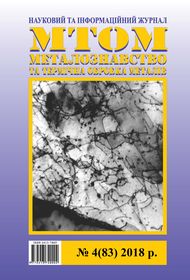Influence of the relationship between component compositions on basis of mine and oxide aluminum on heat and electrical engineering, properties and microtility
DOI:
https://doi.org/10.30838/J.PMHTM.2413.261218.25.561Keywords:
ceramic composite material, plasma spraying, heat shielding, heat and electrotechnical properties, wear resistance, microhardnessAbstract
Abstract. Problem statement. Problematic issues in the field of friction and wear occur mainly when used in extreme conditions of work parts. It increasingly meets the requirements of metal ceramics. But designers do not always have reference data on the selected metal ceramics. In this work, such properties as hardness, wear resistance and thermal properties of metal-ceramic coating on the basis of copper and aluminum oxide are investigated. (Cu + Al2O3). Methodology.. The hardness was evaluated by measuring the microhardness of the PMT-3 device with a load of 0,2 kg, the incisions were carried out in a step of 0,1 mm. To determine the microhardness, samples of the type "metallization figure" were made on the standardized modes of the plasma torch. From these specimens, research slabs were made. Wear resistance was estimated by the time, for which the layered coating with a thickness of 1 mm is stitched with abrasive material. The abrasive material is an electroporation of 100…200 microns in diameter, which was fed with compressed air at a pressure of 0,6 MPa. The distance from the nozzle to the coating was 10 mm, and the abrasive costs 6,4∙10-4 kg/s. The plate method was used to determine the thermal conductivity in the temperature range of 100…700 °C. For the thermal stability test, the method of alternating heating and sharp cooling of the samples by compressed air jet of the regime wasused: 20…900…20 °C. When measuring the volumetric resistance, an electronic unit of type E6-3 was used, and the electrodility was determined using the AII-70 apparatus. Results.. The hardness of the composite coating Cu + Al2O3 increases to 6,6 times withan increase in the percentage of Cu + Al2O3 to 90 %. With increasing distance from the surface of the spray coating in depth, the microhardness decreases. In this case, the steepness of the fall for coatings with a higher content of aluminum oxide than for coatings with low potassium content. The durability of the coatings is proportional to the microhardness, with the increase in the percentage of copper in the coating, the coefficient of thermal conductivity increases to the thermal conductivity of copper. Fluctuation of the coefficient of thermal conductivity depends on the thickness of the coating. Thermal stability of plasma coatings is maximal when the amount of ceramic (Cu + Al2O3) and metal (Cu) components is approximately the same. The same ratio can be used not only in the protective, but also in the electrical insulation. Scientific novelty. Significantly expanded information on the technological properties of coatings based on copper and ceramics. Practical significance. The results of the study can serve as reference material for designers and technologists of machine-building enterprises.
References
Borisov Yu.S., Kharlamov Yu.A., Sidorenko S.L. and Ardatovskaya Ye.N. Gazotermicheskiye pokrytiya iz poroshkovykh materialov : spravochnik [Thermal coatings from powder materials : directory]. Kyiv : Naukova Dumka, 1987, 543 p. (in Russian).
Antsiferov V.I., Shmakov A.M., Ageyev S.S. and Bulanov V.Ya. Gazotermicheskiye pokrytiya [Thermal coatings]. Yekaterinburh: UV Science, 1994, 318 p. (in Russian).
Mulyakov L.M. Zashchitnyye pokrytiya detaley gazoturbinnykh dvigateley [Protective coatings for parts of gas turbine engines]. Tekhnologiya metallov [Technology of metals]. 2000, no. 11, pp. 20–29. (in Russian).
Ilichev M.V, Isakayev M.Kh., Zhelobtsova G.A., Katarzhis V.A., Spektor N.O.and Filippov G.A. Effektivnyy metod plazmennogo naneseniya zharostoykogo pokrytiya na mednuyu osnovu [Effective method of plasma deposition of heat-resistant coating on copper base]. Sbornik statey konferentsii po fizike nizkotemperaturnoy plazmy [Collect of articles of the Conference on the physics of low-temperature plasma]. FNTP–2001. Petrozavodsk : July 1–7, 2001. (in Russian).
Downloads
Published
Issue
Section
License
Authors that are published in this journal agree to follow the conditions:
Authors reserve the right to the authorship of his work and cede the right to the journal of first publication of this work on conditions of the license under the Creative Commons Attribution License, which allows others to distribute it freely with the obligatory reference to the author of the original work and the first publication of the work in this journal.

